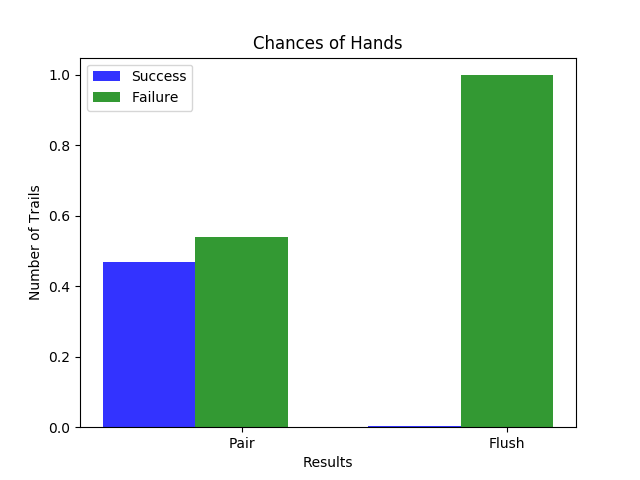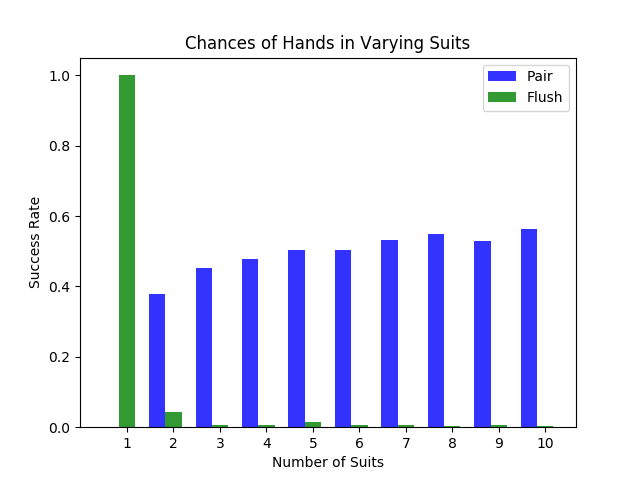Though writing a Freecell game in text form with Python is the least serviceable project I have done with Python🤷🏻♀️. The card and deck objects are reusable for other serious purposes. Thanks to Object-Oriented (OO) programming, I have the excuse for why I wrote a Freecell game that only can be played in terminal 🤦🏻♀️
So, I will do some simulation and statistical analysis in this project to pretend I'm a data scientist (alas, the Sexiest Job of the 21st Century).
Or, maybe I can use this project along with my useless text format freecell to construct a portfolio as a make-you-a-data-scientist consultant. I invented a job in the moment of writing this README documentation, which can provide project ideas and computation solutions to help someone (my potential clients) show off that they are data scientists). If you are interested in claiming yourself as doing or being able to do Sexiest Job of the 21st Century but had headaches in coding, math, and technical writing, shoot me an email  , I can offer you the services to free your hand and head LOL
, I can offer you the services to free your hand and head LOL
To calculate the mean face value of repeated drawing from a deck of cards with replace, the first step is to implement a random draw from a deck of cards. Using the deck class I wrote for Freecell to initialize a standard deck of cards (4 suits, 13 cards in each suit), and get the face value of each card in that standard deck via get_face_index() in card class.
To execute a random draw with replacement, I call choices function in random module. To repeat the random draw, just specify the parameter k in the random.choices() . The random choice() function returns a list of face value generated by each random draw. And then I call mean function from numpy module to calculate the mean face value of the 1000 random draw. After print the 1000 drawn card face value I get, np.mean() calculate the mean value is 7.045.
# set seed to reproduce the randon draw result
random.seed(1005)
my_deck = Deck(1, 13, 4)
my_deck.shuffle()
# get face index for each card
face_list=[]
for i in range(52):
face_list.append(my_deck.draw_card().get_face_index())# Random draw from a deck of cards 1000 times
sample_result = random.choices(face_list, k=1000)
# Print the face value for 1000 drawn cards
transposedMatrix = np.transpose(sample_result)
print (transposedMatrix)# Mean face value of 1000 draw
print(np.mean(sample_result))
>>> 6.987The plot below shows the number of occurrences for each face value. We can see that the numbers of occurrence of every value from 1 to13 are bounded by 60 and 85.
To obtain more sound prove for the mean value from 1000 times random draw, I repeat the same procedure (conduct 1000 random draw from a deck of card with replacement, and then calculate the mean face value from the 1000 drawn card) above 100, 000 times by writing a function mean_test().
# Write a function to repeat 1000 draws
# Set default to test 10-time repeat
def mean_test(meanTest_size = 10):
meanTest_result = []
for m in range(meanTest_size):
test_deck = Deck(1, 13, 4)
test_deck.shuffle()
face_list = []
for i in range(52):
face_list.append(test_deck.draw_card().get_face_index())
sample_result = random.choices(face_list, k=1000)
newValue = np.mean(sample_result)
meanTest_result.append(newValue)
return meanTest_result# repeat the experiment above 100 times, save every mean to the list
run_result = mean_test(100000)Then I map each result on a plot to show the distribution of results from 100,000 times trails. We can see that most of the mean values obtained from one hundred thousand time trials fall into the [6.5, 7.5] interval.
To calculate the frequency of pair from repeated hand-draw, I firstly write a function is_pair() to test whether there is a pair in hand. And then draw a hand of card from a randomly shuffled deck to test whether there is a pair.
def is_pair(hand_list):
'''
Test whether there is a pair in the hand.
:param hand_list: A hand draw from a random shuffled deck
:return: True is there is a pair; False none of cards are pair.
'''
face_list = []
for i in range(5):
face_list.append(hand_list[i].get_face_index())
# if
if len(set(face_list)) < 5:
return True
else:
return False def pair_test():
'''
Draw a hand from a draw shuffled deck, and test whether there is a pair
:return: if there is a pair, return 1, otherwise return 0.
'''
my_deck.shuffle()
hand_list = []
for i in range(5):
hand_list.append(my_deck[i])
if is_pair(hand_list) == True:
return 1
else:
return 0To obtain the frequency of pair occurrence, I repeat the procedure (draw a hand from a randomly shuffled deck, and then test whether there is a pair) 1000 times. The pair_test() result printed as 1 if there is a pair in the drawn hand, 0 otherwise.
def get_pair_rate(pairTest_size = 1000):
'''
draw a hand from a random shuffled deck n times,
return the approximated probability of getting a pair
:param pairTest_size: times of random draw
:return: the approximated probability of getting a pair
'''
pairTest_result = []
for i in range(pairTest_size):
newValue = pair_test()
pairTest_result.append(newValue)
pair_rate = sum(pairTest_result) / pairTest_size
transposedMatrix = np.transpose(pairTest_result)
print (transposedMatrix)
return pair_rate print(get_pair_rate())
>>> 0.508To calculate the frequency of flush, following similar steps like calculating the probability of getting a pair above, but the function to test is is_flush() and flush_test() to check whether a hand is a flush.
def is_flush(hand_list):
'''
Test whether there is a flush in the hand.
:param hand_list: A hand draw from a random shuffled deck
:return: True is there is a flush; False otherwise.
'''
suit_list = []
for i in range(5):
suit_list.append(hand_list[i].get_suit_index())
if len(set(suit_list)) == 1:
return True
else:
return Falsedef flush_test():
'''
Draw a hand from a draw shuffled deck,
and test whether there is a flush
:return: if there is a flush, return 1, otherwise return 0.
'''
my_deck.shuffle()
hand_list = []
for i in range(5):
hand_list.append(my_deck[i])
if is_flush(hand_list) == True:
return 1
else:
return 0And I was then writing a function get_flush_rate() to draw 1000 hands with replacement from a deck of randomly shuffled cards and test each whether there is a flush. The flush_test() result printed as 1 if there is a pair in the drawn hand, 0 otherwise. Finally, calculate the frequency of flush occurrence to approximate the probability.
def get_flush_rate(flushTest_size = 1000):
'''
draw a hand from a random shuffled deck n times,
return the approximated probability of getting a pair
:param pairTest_size: times of random draw
:return: the approximated probability of getting a pair
'''
flushTest_result = []
for i in range(flushTest_size):
newValue = flush_test()
flushTest_result.append(newValue)
flush_rate = sum(flushTest_result) / flushTest_size
transposedMatrix = np.transpose(flushTest_result)
print (transposedMatrix)
return flush_rateprint(get_flush_rate())
>>> 0.006To visualize the approximated probability of pair and flush occurrence, I plot 1000-time trails from pair_test() and flush_test() using a bar plot below. The blue bar is the rate of occurrence in 1000 random draws for pair and flush. Respectively, the green bar is the complement of its occurrence. The pair frequency shows on the left, and the flush frequency on the right.
Given the experiment in the last part, now we are varying the number of suits from 1 to 10 to see the change of chances of pair and flush. Therefore, I write to functions to run the pair experiment and flush experiment, respectively, the number of suits as a parameter to manipulate easily.
def change_pair_test(n_suits = 4, pairTest_size = 1000):
'''
:param n_suits: number of suits in the deck of cards
:param pairTest_size: number of random draw of hands of cards
:return: the frequency of pair occurrence
'''
change_pairTest_result = []
for p in range(pairTest_size):
the_deck = Deck(1, 13, n_suits)
the_deck.shuffle()
hand_list = []
for i in range(5):
hand_list.append(the_deck[i])
newValue = is_pair(hand_list)
change_pairTest_result.append(newValue)
change_pair_rate = sum(change_pairTest_result) / pairTest_size
return change_pair_rate# conduct change_pair_test varying number of suits from 1 to 10
pair_change = []
for i in range(10):
newValue = change_pair_test(n_suits = i+1, pairTest_size = 1000)
pair_change.append(newValue)
print(pair_change)
>>> [0.0, 0.379, 0.452, 0.477, 0.504, 0.503, 0.533, 0.549, 0.528, 0.564]From 1 suit to 10 suits, the frequency of pair occurrence increase from 0 to 57.7%. Since in a single suit, each face value is unique, the chance of getting a pair is 0.
def change_flush_test(n_suits = 4, flushTest_size = 1000):
'''
:param n_suits: number of suits in the deck of cards
:param pairTest_size: number of random draw of hands of cards
:return: the frequency of flush occurrence
'''
change_flushTest_result = []
for p in range(flushTest_size):
the_deck = Deck(1, 13, n_suits)
the_deck.shuffle()
hand_list = []
for i in range(5):
hand_list.append(the_deck[i])
newValue = is_flush(hand_list)
change_flushTest_result.append(newValue)
change_flush_rate = sum(change_flushTest_result) / flushTest_size
return change_flush_rate# conduct change_flush_test varying number of suits from 1 to 10
flush_change = []
for i in range(10):
newValue = change_flush_test(n_suits = i+1, flushTest_size = 1000)
flush_change.append(newValue)
print(flush_change)
>>> [1.0, 0.043, 0.007, 0.006, 0.015, 0.007, 0.005, 0.002, 0.006, 0.004]From 1 suit to 10 suits, the frequency of flush occurrence drop from 1 to 0.1%. Since in a single suit, every card is the same suit, the chance of getting a flush is 1.
Plot the results obtained from above via matplotlib.pyplot, we can see the chance of pair and flush occurrence when varying suits. The green bars show the possibilities of pair, and the blue bars show the chances of flush. The plot echoes with the data list I got in the last part.



